Planet Dinosaur – New Giants
Skorpiovenator, Mapusaurus & Argentinosaurus
In this programme we examine the new giants, the heavyweights of the
dinosaur world. Its only in recent years that we have unearthed the biggest
dinosaurs that ever lived. Animals on such a huge scale it is difficult to
comprehend.
But, just why and how did these titans grow so massive, and could any
animal attack such such a huge beast. One of these giants has eclipsed
all others. At 35 metres it was as long as Diplodocus, yet this dinosaur
was 7 times as heavy.

Chaoyangopterid Pterosaur
The first glimpse this new giant was made in 1990 during a dig in
Argentina. In Patagonia, a fossil was pulled from the ground. It was a
single vertebra, but it was as tall as a human being.
Other bones followed. They belonged to the biggest dinosaur ever
known to have walked the Earth. It lived in South America 95 million
years ago, in a world very different from our own. A world that is only
now giving up its secrets.
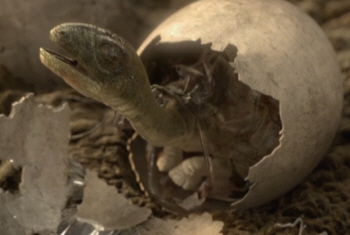
A Hatchling
The start of a new life, but on these plains, danger is never far
away. A Chaoyangopterid Pterosaur, a flying, scavenging dinosaur is
attracted to the easy prey of the nest site.
Throughout the late 1990s extraordinary dinosaur remains were
discovered in Argentina. At one location, Auca Mahuevo, a nest site was
found, so full of dinosaur eggs that they could barely avoid crushing
them underfoot. Some eggs even contained exquisitely preserved dinosaur
embryos.
Then, in 1999, at the same nest site a complete dinosaur skeleton was
uncovered. It appeared they’d found the parent. But, it wasn’t the
parent, it was a Skorpiovanetor, a predator. The skeleton found at the
nest site was almost certainly a nest raider preying on the hatchlings.
The hatchlings real parent and the owner of the enormous vertebra is
Argentinosaurus, a plant-eating giant that dwarfs everything around it.
From the bones that were found we’ve calculated that Argentinosaurus was a massive 35m long and weighed as much as 75 tons.
When born, the hatchlings weigh a paltry 5kg and need to fend for
themselves immediately. From studying the embryos and looking at the
bones of the adults, we know that the growth rate of these giants was
phenomenal. Over 40 years they grow from 5kg to 75,000 kg. At their peak
its been calculated that they grow up to 40 kg every day.
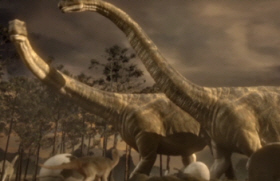
Argetinosaurus
The dinosaur embryos are so well preserved, we can see they already
have their teeth in preparation for a lifetime of eating. But, becoming
a giant takes more than turning tons of food into muscle, its about the
success and survival of the species for millions of years.
One way to increase the chances of survival is having lots of
offspring and the best way to do that is by laying eggs, lots of eggs.
The nest site in Patagonia stretches for an astonishing 15 km and
contains tens of thousands of eggs and the site was used continuously
for hundreds of thousands of tears. For killers like Skorpiovenator
these nest sites provide a feast. But, with thousands of hatchlings it
had little impact on the success of the species and posed no threat to
the adults.
But, whenever we find a giant plant-eater, there is always a giant
killer lurking nearby. And, sure enough, another startling discovery was
made in Argentina.
In the same region, a nearly complete skeleton of an enormous
predator was unearthed, amazingly well preserved. The skull alone was
over a metre and a half long and when a second, even larger specimen was
found it became clear this was bigger than any predator that had been
found before, bigger than T. Rex.
In fact, whenever giant plant-eaters have been discovered, it appears a
giant predator lived alongside them. From America to Europe and Asia we see
the same relationship repeated.
But, there was one place on Earth that remained a mystery. For decades,
Africa was the forgotten continent, a huge gap in our understanding of Planet
Dinosaur.
Then in 2000, a cluster of bones was unearthed in North Africa. The bones
were huge. One single leg bone was as tall as a human.
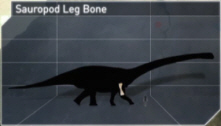
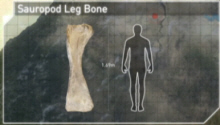
Sauropod Leg Bone
It seemed this too was a land of giants. That could only mean one thing,
there must also be a giant killer. 95 million years ago, this was a dry and
difficult place to survive. Food and water were hard to come by and often
found in only one place, along the banks of a river that has earned the name
‘River of Giants’.
Paralititan is a 45 ton animal and the undisputed heavyweight here. For
an animal this size, its not easy keeping cool, being near water is vital.
But, rivers are dangerous places. This is not a good place for a young
animal to get stuck in the mud and its not just because of crocodiles. This
river holds much, much bigger threats.
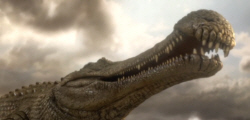
Sarcosuchus
It may look familiar but this is no ordinary crocodile, with a skull
nearly 2 metres long, its more than twice the size of any modern Croc.
This is Sarcosuchus – weighing as much as 8 tons, its the undisputed
king of crocodiles, a cold-blooded killer and if it can drag its prey
into the water and drown it, even better. But, even for a deadly
predator like this, ‘River of Giants’ holds dangers.
Across the world, from Africa to Argentina, giant sauropods roamed
far and wide. A herd of Argentinosaurus are on the move, travelling
across a swamp covered with volcanic ash. Its a dangerous place to be if
you’re living in the shadows.
These giants are so massive, they turn the sand beneath their feet
into quicksand, creating huge death-traps with every step. Its a danger
that was graphically revealed in 2010 when an astonishing set of fossil
footprints were unearthed. After months of painstaking examination some
of the fossil footprints were found to contain bones of other animals.
One exposed the bodies of two mammals, ten small dinosaurs, two
crocodile and a turtle.!

Argentinosaurus
Becoming this big isn’t easy, it requires some serious eating.
Argentinosaurus weighed around 75 tons. A 6 ton African elephant has to eat
for 18 hours a day to keep going. Argentinosaurus weighs more than 10 times
as much, so how did they get enough food? They turn themselves into the
most efficient eating machine the world has ever known. Everything about
them is designed to get the most food in and the most calories out, with the
least effort.
Their long necks give them access to more food without moving but, the
way they eat is the crucial bit. These giants don’t waste time chewing. They
rip and gulp down leaves whole which are digested by bacteria in their
massive gut. Not chewing means it doesn’t need a big heavy head, teeth and
muscular jaws, which also means the neck can gow so long, able to reach food
no other animal can reach.
Being so big means you’re off the menu for most predators. Here, however,
there’s a killer in a completely different league. Over 10m long and
weighing around 4 tons, Mapusaurus is the newly discovered killer on the
block. On its own, even this killer is not a match for a fully grwon
Argentinosaurus. But, this giant killer is not alone.
For years it was
thought that an adult Argentinosaurus would be too big for any predator to
tackle. But, in 2006, a new discovery suddenly made even the biggest
dinosaur a lot more vulnerable. As they dug into the Argentinean dirt, they
didn’t find just one predator buried here.
The skeletons of at least 7
Mapusaurus of different ages and sizes were found together. It suggested
this was a group, a giant killer that appears to hunt in gangs and more than
capable of taking on the very biggest dinosaurs. Not even a fully grown
Argentinosaurus is safe from this group.
Mapusaurus teeth are perfectly
designed, like blades, to slice off chunks of flesh. With prey solarge, a
single bite isn’t alwats fatal. It appears Mapusaurus could just snack,
feeding from its victim without actually killing it. The victim surviving to
provide more food at a later date.
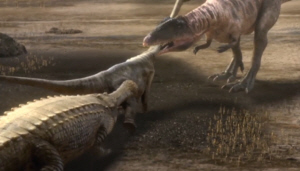
Paralititan Sandwich
Its the youger, smaller animals that are in the greatest danger from
predators like Sarcosuchus, and here in Africa there is nowhere to hide. The
young Paralititan is in imminent danger from Sarcosuchus but, this is not
the only threat.
Around the ‘River of Giants’ there is another killer –
Carcharodontosaurus. A predator always looks for the easiest kill, the weak,
injured or young. The Paralititan is all three.
Enough is known about
Sauropod anatomy to conclude that a 70 ton carcass is made up of 11 tons
bone, 3.5 tons blood, 4 ton of hide & skin, 15 tons of fat and 39 tons
of meat, enough to feed a whole ecosystem for days.







